
Current Projects
Axion Longitudinal Plasma HAloscope (ALPHA)
Links: ALPHA Website, Keith Baker, Charles Brown, Karsten Heeger, Steve Lamoreaux, Konrad Lehnert, Reina Maruyama
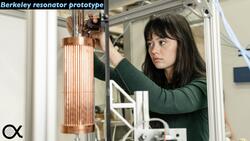 ALPHA is looking for a theorized particle called the axion, which is candidate for dark matter that, if detected, would provide important clues to the nature of dark matter and the constitution of the mass content of the universe. ALPHA, which will be located at Wright Lab, will build on the success of HAYSTAC (see below) and search for even higher mass axions by employing a novel axion detector called a plasma haloscope. The ALPHA collaboration was founded in May 2021. Yale joined the collaboration in 2023.
ALPHA is looking for a theorized particle called the axion, which is candidate for dark matter that, if detected, would provide important clues to the nature of dark matter and the constitution of the mass content of the universe. ALPHA, which will be located at Wright Lab, will build on the success of HAYSTAC (see below) and search for even higher mass axions by employing a novel axion detector called a plasma haloscope. The ALPHA collaboration was founded in May 2021. Yale joined the collaboration in 2023.
Canadian Hydrogen Intensity Mapping Experiment (CHIME)
Links: CHIME Website, Laura Newburgh
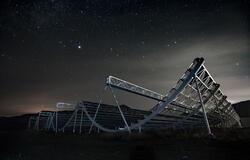
The Canadian Hydrogen Intensity Mapping Experiment (CHIME) is radio telescope with a set of 4 cylindrical dishes, each 100m long x 20m wide, located at the Dominion Radio Astrophysical Observatory (DRAO) in British Columbia, Canada. Data from CHIME will be processed to form a 3-dimensional map of hydrogen density, which will be used to measure the expansion history of the universe and discover insights about Dark Energy, a mysterious component that makes up ~72% of the energy density of the Universe and is causing the expansion of the Universe to accelerate.
Cosmic Microwave Background Stage 4 (CMB-S4)
Links: CMB-S4 website, Laura Newburgh
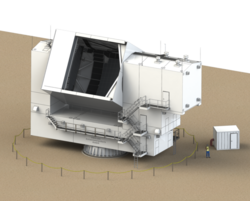 CMB-S4 is the next-generation ground-based cosmic microwave background experiment. CMB-S4 employs twelve telescopes at the South Pole and in the Chilean Atacama desert to survey the sky with 500,000 cryogenically-cooled superconducting detectors. Laura Newburgh is the Data Acquisition lead of CMB-S4.
CMB-S4 is the next-generation ground-based cosmic microwave background experiment. CMB-S4 employs twelve telescopes at the South Pole and in the Chilean Atacama desert to survey the sky with 500,000 cryogenically-cooled superconducting detectors. Laura Newburgh is the Data Acquisition lead of CMB-S4.
COSINE-100
Links: COSINE-100 website, DM-Ice website, Reina Maruyama
 COSINE-100 is a NaI(Tl) direct detection dark matter experiment, a collaboration between the DM-Ice and KIMS experiments. The first phase of the experiment deployed 106 kg of NaI(Tl) at Yangyang underground laboratory in South Korea. COSINE-100 started to take physics data in September 2016 with an aim to test DAMA Collaboration’s claim that they have made a direct detection of dark matter with their thallium-doped sodium iodide detectors. Prof. Reina Maruyama is the Principal Investigator of the experiment.
COSINE-100 is a NaI(Tl) direct detection dark matter experiment, a collaboration between the DM-Ice and KIMS experiments. The first phase of the experiment deployed 106 kg of NaI(Tl) at Yangyang underground laboratory in South Korea. COSINE-100 started to take physics data in September 2016 with an aim to test DAMA Collaboration’s claim that they have made a direct detection of dark matter with their thallium-doped sodium iodide detectors. Prof. Reina Maruyama is the Principal Investigator of the experiment.
Dark Energy Spectroscopic Instrument (DESI)
Links: DESI website, Charles Baltay
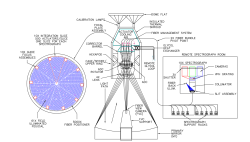 The Yale team is designing, testing and building a DESI Fiber View Camera System for the DESI instrument on the Mayall 4-meter telescope at Kitt Peak National Observatory near Tucson, Arizona, to vastly improve the precision of DESI, which has 5,000 fibers in robotic actuators simultaneously taking data.
The Yale team is designing, testing and building a DESI Fiber View Camera System for the DESI instrument on the Mayall 4-meter telescope at Kitt Peak National Observatory near Tucson, Arizona, to vastly improve the precision of DESI, which has 5,000 fibers in robotic actuators simultaneously taking data.
Haloscope At Yale Sensitive To Axion CDM (HAYSTAC)
Links: HAYSTAC website, Steve Lamoreaux, Reina Maruyama
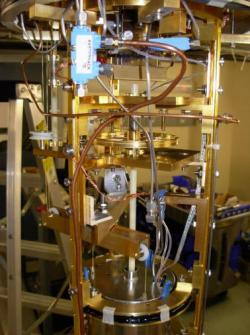
IceCube
Links: IceCube, Reina Maruyama
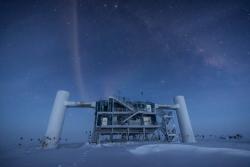 IceCube is the world’s largest neutrino detector, encompassing a cubic kilometer of ice at depths between 1,450 and 2,450 meters at the South Pole. IceCube uses 5160 photomultiplier tubes (PMTs) to search for neutrinos from the most violent astrophysical sources: events like exploding stars, gamma-ray bursts, and cataclysmic phenomena involving black holes and neutron stars. IceCube is a powerful tool to search for dark matter and could reveal the physical processes associated with the enigmatic origin of the highest energy particles in nature. In addition, exploring the background of neutrinos produced in the atmosphere, IceCube studies the neutrinos themselves; their energies far exceed those produced by accelerator beams.
IceCube is the world’s largest neutrino detector, encompassing a cubic kilometer of ice at depths between 1,450 and 2,450 meters at the South Pole. IceCube uses 5160 photomultiplier tubes (PMTs) to search for neutrinos from the most violent astrophysical sources: events like exploding stars, gamma-ray bursts, and cataclysmic phenomena involving black holes and neutron stars. IceCube is a powerful tool to search for dark matter and could reveal the physical processes associated with the enigmatic origin of the highest energy particles in nature. In addition, exploring the background of neutrinos produced in the atmosphere, IceCube studies the neutrinos themselves; their energies far exceed those produced by accelerator beams.
Nancy Grace Roman Space Telescope Mission
Links: Roman website, Charles Baltay, Nikhil Padmanabhan
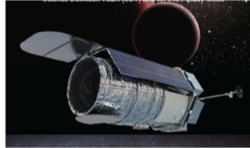 The Nancy Grace Roman Space Mission (originally known as WFIRST, the Wide Field Infrared Survey Telescope) is a large field of view space observatory with a 2.4 meter diameter telescope with an instrument optimized for the near infrared wavelengths. The Yale group was actively involved in the design of the mission. The main scientific interest of the Yale group is a cosmological survey observing a large sample of TypeIa supernovae to study the nature of the mysterious unknown major component of our universe we call Dark Energy. The mission is now well along in construction by NASA, to be launched in a far Earth L2 orbit in a few years from now. The Yale group at this time is very much involved in developing the data analysis algorithms and the software for the supernova survey.
The Nancy Grace Roman Space Mission (originally known as WFIRST, the Wide Field Infrared Survey Telescope) is a large field of view space observatory with a 2.4 meter diameter telescope with an instrument optimized for the near infrared wavelengths. The Yale group was actively involved in the design of the mission. The main scientific interest of the Yale group is a cosmological survey observing a large sample of TypeIa supernovae to study the nature of the mysterious unknown major component of our universe we call Dark Energy. The mission is now well along in construction by NASA, to be launched in a far Earth L2 orbit in a few years from now. The Yale group at this time is very much involved in developing the data analysis algorithms and the software for the supernova survey.
Quasar Equatorial Survey Team (QUEST) Camera
Links: Charles Baltay
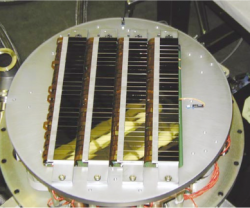 The large area QUEST camera is a mosaic of 112 CCDs covering the full field of view of the 40” ESO Schmidt Telescope at the LaSilla Observatory of the European Southern Observatory (ESO) in Chile that was built at Yale and Indiana University. The camera has been used for the Yale-run La Silla-QUEST Variability Survey and the team is planning, with an international collaboration, to upgrade the camera and build a new spectrometer for another 5-year survey.
The large area QUEST camera is a mosaic of 112 CCDs covering the full field of view of the 40” ESO Schmidt Telescope at the LaSilla Observatory of the European Southern Observatory (ESO) in Chile that was built at Yale and Indiana University. The camera has been used for the Yale-run La Silla-QUEST Variability Survey and the team is planning, with an international collaboration, to upgrade the camera and build a new spectrometer for another 5-year survey.
Rydberg Atoms at Yale (RAY)
Links: RAY website, Charles Brown, Reina Maruyama
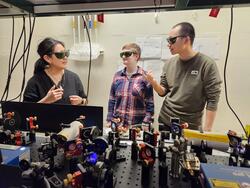
To extend the mass range accessible by axion dark matter search experiments, the RAY group is is developing a single-photon detector for haloscope experiments, such as HAYSTAC and ALPHA. The detector is based on microwave transitions between highly excited Rydberg states in potassium atoms.
Simons Observatory
Links: Simons Observatory website, Laura Newburgh
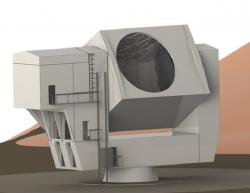 The Simons Observatory is a state-of-the-art array of radio telescopes located in the high Atacama Desert in Northern Chile inside the Chajnantor Science Preserve and will study the Cosmic Microwave Background (CMB) to determine how the universe began, what it is made of, and how it evolved to its current state.
The Simons Observatory is a state-of-the-art array of radio telescopes located in the high Atacama Desert in Northern Chile inside the Chajnantor Science Preserve and will study the Cosmic Microwave Background (CMB) to determine how the universe began, what it is made of, and how it evolved to its current state.
Future Projects
The Hydrogen Intensity Mapping and Real-time Analysis eXperiment (HIRAX)
Links: HIRAX website, Laura Newburgh

HIRAX is a radio telescope array of 128 dishes, each 6m in diameter, located in the Karoo Desert in South Africa, which will map nearly all of the Southern sky in radio continuum and neutral hydrogen line emission over a frequency range of 400 to 800 MHz. The primary goal of HIRAX is to use 21-cm intensity mapping to measure baryon acoustic oscillations (BAOs): these are remnant ripples in the distribution of galaxies that are imprinted by primordial sound waves that existed in the early universe. The characteristic BAO length scale can be used as a “ruler” for charting the expansion history of the universe and for shedding light on the nature of dark energy.

